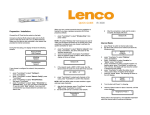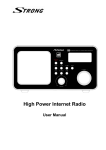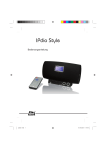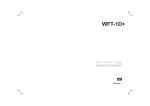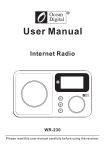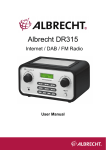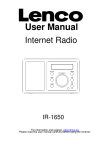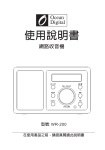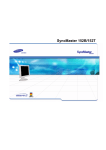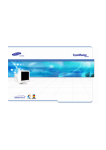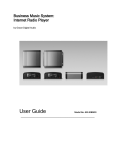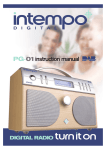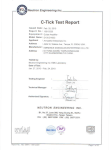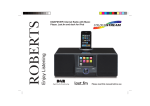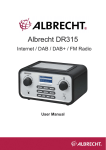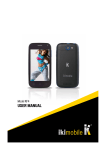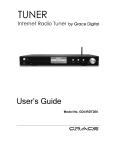Download Location of Controls 1. Power button 2. Power LED indicator 3
Transcript
Location of Controls 1. Power button 2. Power LED indicator 3. Remote control lens 4. LCD display 5. Previous / Play button 6. Mode changing button 7. Back button 8. Tuning / Select button 9. 6.35 mm earphone jack 10. SD card slot 11. External Wifi antenna 12. Ethernet jack 13. Coaxial Digital output 14. Toslink Digital output 15-16. RCA analog line out 17. FM antenna socket 18. USB host 19. DC IN – power input 20. Main on/off switch SETTING UP Those steps for connecting your radio to your network Step 1- Switching on the radio; Plug the cable from the AC adapter into the socket labeled 5V 1.2A DC at the back of the radio, then switch on at the mains by the main switch power on the rear cabinet Caution: Use only the mains adapter supplied with the radio. Connecting a power supply with a different rating will cause permanent damage to the radio and may be hazardous. The display on the front of the radio will light up and say: Welcome to IPdio Radio Then show Reciva Enabled ARM Powered After a few seconds, it will show the Starting… Then it will enter to standby mode to show the initial time 00:00, you should press “Power” to turn on the unit, then it will bring you to the Wizards sets: Initialising Network / If it complete the initialing, it will auto scan the ESSID as follow: Scanning ……. It will list all the ESSID names that can be detected, select the ESSID belong to yours, it will ask you to input the correct WEP(Wired Equivalent Privacy) or WPA(Wi-Fi Protected Access) code. If your ESSID does not require a WEP or WPA code, the unit will connect to the ESSID automatically and display as follow: Network OK Or if you are requested to input the encryption, you can do the following: 1. Select your ESSID from the list: Select Network Linksys 2. It will show as follow: Enter WPA/WEP key Note: The encryption code would have been set up by the person who set up and configured your network. After 3 seconds the display goes into the code entry screen. If the display does not automatically go into the code entry mode, press the TUNE/SELECT button. To enter the code, use the TUNE/SELECT to select each character of the code, push down the TUNE/ SELECT button to confirm each character. 3. Make sure the character you want is shown in the centre of the display to be able to select it. <END <> A BCDEF > 4. If you complete the key then you can use “END” to confirm. The display shows “Connecting to network” as the radio connects to the network. Connecting to Network Connecting to Linksys 5. If the connecting is OK, it will show you Station Update From Reciva 6. After the station update, it will display the following menu : Internet Radio My Stuff Changing the volume – for Earphone only Note: The volume control on the unit is just for adjusting the volume for the earphone. You can change the volume by turning the TUNE clockwise to increase the volume and anticlockwise to decrease the volume. The display will show the volume bar. You cannot change the volume when you are in a menu or when the radio is connecting to a station. To change the volume for the external speakers, you need to use the volume control from the external speakers. Step 2-How to set your radio In the main menu, you can find <Settings> then you can do your radio basic settings as Alarm Clock Settings <Network configuration> Network Config Version Press “Select” to do the setting, adjust the TUNE button to your desired option. You can find some sub-menus in it and one of them you can see <Wired/Wireless> Edit Config Wired/Wireless You can select Auto, Wired only or Wireless only. If you select Auto, it will detect automatically for either wired connection or wireless connection. If you select Wired Only, it will only connect through Wired connection. If you select Wireless Only, it will only connect through Wireless Wi-Fi connection. Configuring the radio to only use a wired Ethernet connection Selecting ‘Wired Only’ will cause the radio to reboot and then only use its Ethernet connection to communicate with the network. The radio will also disable its wireless network capabilities. Configuring the radio to only use a Wi-Fi connection Selecting the ‘Wireless Only ‘ option from the ‘ Wired/Wireless’ menu will cause the radio to reboot and then only use its Wi-Fi connection to communicate with the network. The radio will also disable its Ethernet connection. Configuring the radio to use either an Ethernet or a wireless connection Selecting the ‘Auto’ option from the ‘Wired/Wireless’ menu will cause the radio to reboot and then attempt to establish and then attempt to establish an Ethernet connection, if it is available, to communicate with the network. Otherwise, the radio will attempt to establish a Wi-Fi connection to the network. Once the radio has established a certain type of connection to the network, then this type of connection will remain in use while the radio is on. <Scan for network> You will be guided to how to set the wireless application with the wizards. Please refer to Step 1 above for details. <Enter network> You can input the network name by using this feature <View Config> To view the current configuration of the network <Edit config> You can set the DHCP auto ON or OFF and if this DHCP ON is set, this device will auto set and get the IP address and gateway DNS settings automatically. If you set the DHCP off, you will be asked to input these address or number manually for the network configuration. TIPS: Please set DHCP ON as default and you can get the network connection automatically. <Signal Warning> It allows you to choose whether or not the Internet radio displays a warning message when its network signal strength is low. You can enable this feature by selecting ‘Signal Warning Other options under Setting <Version> Displays the versions number of the various part of software on you Internet radio. You may be requested for these information when you need assistance on technical support. <Upgrade Firmware > Use this option to download new firmware for the radio from the Reciva portal on the internet. If there is new firmware available, the radio will pop out a message and ask if you want to download it or not. At this stage, you can still return to the previous menu by pressing the Back button. A firmware upgrade may take several minutes, so do no switch off the power to the radio until the operation is complete otherwise the radio may become permanently damaged. <Language> You can select your desired language from the menu <Factory Reset> You can select this option to clear all the settings you have made and it will resume to the factory’s default settings. If you confirm to do this, all the Presets, Language, selected ESSID, network configuration etc will be resumed to default setting. <Register> You can use this key number to register your unit on Reciva’s portal website. Please see the last instruction to know how to register you unit <Set Time/Date> You can set the time and day of your local time. Once your unit is connected to Internet successfully, the time and date will be set with Greenwich standard time. <Backlight>, You can set the LCD backlight level for active mode, inactive mode and standby mode. Selecting this option will alter the internet radio’s backlight values. 1. After selecting the ‘Backlight’ menu item, the radio will display three modes: ‘Inactive’, ‘Active’ and ‘Standby’ as follow: - Inactive mode: when there is no activity on the radio for 30 seconds. - Active: when there is activity on the radio, e.g. controlling the buttons/making selection on the radio - Standby: When the radio is being turned off. 2. Rotate the knob to highlight the desired menu mode and press SELECT. 3. The radio will now display the current backlight value for the menu mode. You can alter this value by rotating the knob to increase or decrease it. <Contrast> You can set the LCD contrast level by adjusting the knob 1. After selecting the ‘Contrast’ on the menu, the radio will display the current value of LCD contrast ratio. 2. Tuning the knob to increase or decrease it until it is at the optimum level. 3. Press SELECT to confirm the change. <UPNP> Allow the user to configure the radio's UPnP device name. When the radio accesses a UPnP server, the server will display the radio's configure device name in its list of clients <WiFi Strength> It shows the strength of the current WiFi signal. Step 3- Listening you internet radio To listen to the desired radio station, follow the steps below 1. Select the station by <Location>: Location Genre Choose a Continent and country from the list. A list of radio stations will be displayed: Caribbean Europe UK Ukraine 2. Select the station by <Genre>: Choose the stations by category or by the type of music, such as the music from 90s, Classical, Dance or Rock music. 90s Adult 3. Press the “Select” button to choose the station you want to listen to, it will display the screen as follow: Loading xxx stations … BBC Radio 1 BBS Radio 1Xtra 4. <Search> function You can search your favorite station by entering the station name. Select <Search> from the menu, and then input the name of the station by using the Tune /Select button. Tuning the button to select the letter and push down to confirm. < END <> A BCDEF > B/ Searching … BBC Radio 1 BBS Radio 2 Step 4- How to enjoy your Media stream Go to <media player>, you can enjoy the music from your PC, SD card or USB drive. MUSIC CONTENT The internet radio is able to playback the following type of music files: FLIE TYPE FLIE EXTENSION SHOWN ON PC MP3 .mp3 Windows Media .wma Real .Ra itunes .aac Ogg Vorbis .ogg (These are the letters that appear after the file name. e.g. MUSIC.mp3) Select “Media Player’ on the menu: My Stuff Media Player Playback music from SD card or USB drive 1. To playback music files from the SD card or USB drive, select <Local Media> from the menu, then press “Select” to enter your local media player. Windows Shares Local Media Note: Please always insert the SD card or USB drive before you turn on the unit. The file cannot be accessed if the SD card or USB drive are inserted under other operation of the unit. 2. It will start scanning the files from the SD card or USB drive. File Scanning… Loading… The music in the local media can be sorted by Album and by Artist: By Album By Artist 3. You can play the music one by one track. Select your desired music, then confirm by selecting “Add to Queue”. Or you can add the whole music folder into the playback queue: [Add to Queue] Music one Streaming music from your PC by UPNP or Windows Shares: UPnP Servers Windows Shares Playback music via ‘Windows Shares’: In order to play the music files you have stored on your PC via the Media player you must ensure the following: - Your PC has the type of music files as listed in the table below The music files on your PC are not 'protected' The music files are stored in the correct location on your PC The music files on your PC are “shared” on the network You know the name of your PC Set up your Windows PC to allow your radio to access your audio files via Windows Shares 1. Please ensure that your PC is available on the network for you Internet radio, then, using windows Explorer, locate the folder where your audio files are stored. 2. Right Click on the folder. 3. Select ‘Properties’. 4. Click on ‘Sharing’. 5. Press the SELECT button, turn the knob until ‘Scan for PCs’ is displayed and press SELECT again. 6. The radio will now display ‘Finding PCs ’. Once the radio has finished, turn the knob to highlight the correct PC. 7. Press the SELECT button. The radio will search for shared folder. 8. Turn the knob to highlight the correct shared folder and press SELECT. 9. The radio will display ‘File Scan…’ as it scans through the media files in the shared folder. Text on the bottom row of the display will change to indicate that the file scan is in progress. If you have a large number of audio files this could take several minutes to complete. 10. Once the radio has finished scanning, it will display’ By Album’. You can now browse through the scanned media files, which will now be organized ‘By Album’,’ By Artist’- if available. Note that the first time the file scan is done a file called ‘.reciva_media_cache’ is written to the folder where the audio files are stored. This is in order to speed up subsequent file scans. Listening to the music from Windows Shares (1) By selecting the “Windows Share” feature, it will scan out the PCs available from the network. Please follow the steps described above to enable the folders shared successfully from your PC. Select the name of your PC, the press the SELECT button. Note: If the PC does not have global file sharing turned on, or a third party firewall is protecting the PC it will not be visible when you scan for it. You may be asked to enter a username and password to access the PC you have selected. This is the same user name and password you would enter for the PC. (2) Finding folders The internet radio will now scan the PC you have selected and display a list of any folders which have got 'sharing' enabled. Note: It will scan out the shared folders from your PC regardless of the type/content of the folder. Select the folders which have the music file, and press the select button. (3) Selecting music You can now view the content of the shared folder by Album or Artist. Use the TUNE/SELECT button to browse through the list. Listening the music by Artist 1. Turn the knob until ‘ By Artist’ is displayed. 2. Press the SELECT button. 3. Turn the knob until the required artist is displayed. 4. Press the SELECT button. Listening the music by Album 1 Turn the knob until the required album name is displayed. 2. Press the SELECT button.’ [Add to Queue]’ will be displayed. 3. Turn the knob until the required track is displayed. 4. Press the SELECT button. The track will begin playing. Listening to a complete shared album 1. Turn the knob until ‘By Artist’ is displayed. 2. Press the SELECT button. 3. Turn the knob until the required artist is displayed. 4. Press the SELECT button. 5. Turn the knob until the required album name is displayed. 6. Press the SELECT button. ‘[Add to Queue]’ will be displayed. 7. Press the SELECT button. The album will begin playing. Queuing up tracks for playback later 1. Select the desired track. 2. ‘Track Added To Queue’ will be displayed. Queuing up albums for playback later. 1. Select the desired album. 2. Press the SELECT Button. 3. Turn the knob until ‘[Add To Queue]’ is displayed. 4. Press the SELECT button.’ Tracks Added to Queue’ will be displayed. Controlling playback 1. Use the STOP button to stop playback. 2. Use the PLAY/PAUSE/STOP button to either pause a currently playing track or to restart a currently paused track or to restart a stopped track. 3. Use the PLAY/PAUSE/STOP button to stop a currently playing when you press and hold the button for 2 seconds. 4. Use the Left arrow button (<)on the remote control to start playback of the previous track in the queue. 5. Use the Right arrow button (>) to start playback of the next track in the queue. Browsing the list of tracks currently queued up for playback 1. Press the BROWSE button on the remote control. The currently playing track name will be displayed. 2. Turn the Tune/Select knob to see which tracks are queued up for playback. 3. If you want to jump to a particular place in the queue the SELECT button when the required track is displayed. Playing tracks in random order 1. Navigate to top-level menu item ‘Media Player’ using the SELECT and BACK buttons. 2. Press the SELECT button. 3. Turn the knob until ‘Playback Mode’ is displayed. 4. Press the SELECT button. 5. Turn the knob until ‘SHUFFLE’ is displayed. 6. Press the SELECT button. 7. Turn the knob to select YES/NO to confirm that shuffle mode should be enabled. Playing tracks in the queue repeatedly 1. Select the individual tracks as described previously. 2. Navigate to top-level menu item ‘Media Player’ using the SELECT and BACK buttons. 3. Press the SELECT button. 4. Turn the knob until ‘Playback Mode’ is displayed. 5. Press the SELECT button. 6. Turn the knob until ‘Repeat’ is displayed. 7. Press the SELECT button. 8. Turn the knob to select YES/NO to confirm that shuffle mode should be enabled. Playback music from ‘UPnP Severs’ You can enjoy the music from the UPnP device, follow the steps below: Setup a Windows PC to allow the radio to access you audio files via a UPnP serves 1. If your PC is running Microsoft Windows XP, then you can use Windows Media Player 11(WMP11) to act as your UPnP( Universal Plug and Play) media server 1.0. Windows Media Player 11 may be downloaded from Microsoft’s website and install by following the instructions detailed in its installation wizard. 2. Once installed , Windows Media Player 11 will create a library from all the media files available to it on your PC. To add new media files to the library, select’ File > Add to Library…> Advanced Options’, Click ‘Add’ and choose the files you wish to add and click’ OK’. 3. You will now need to connect your Internet radio to Windows Media Player 11 and configure it to allow the radio to access your media library. In order to this , you will need to do the following: a. Keep pressing BACK to get to the radio’s top-level menu and then turn the rotary knob to select ‘Media Player’. b. Press SELECT and then turn the knob to highlight ‘ UPnP Serves’. c. Press SELECT and the radio will scan for all available UPnP servers . Note, this may take a few seconds for the radio to complete its scan and before the scan has completed , the radio will display ‘[Empty]’. The radio will continue to display ‘[Empty]’ if no UPnP servers and found. d. 4. After a successful scan. Select your UPnP server, by rotating the knob if there is more than one UPnP server, and then press SELECT (note, your radio will display’ Access Denied’ at this stage) Your PC will now prompt you that a device has attempted to connect to your UPnP server. In order to allow the radio to have access to the media files, you will need to click the ‘Library’ tab from Windows Media Player 11 and select the ‘Media Sharing…’ item to open the ‘Media Sharing’ window. Selecting ‘Media Sharing…’ for Windows Media Player11 : 5. From the ‘Media Sharing’ windows, the radio will be listed as an unknown device. Click on the unknown device listed, then click the ‘Allow’ button and then click ‘OK’ Allowing the Radio to Connect: 6. Once the UPnP server is configure to share media files with the internet radio, you can play the files by doing the following on the radio. 7. Select ‘Media Player’ from the main menu. 8. Press SELECT and then select ‘UPnP Severs’. 9. Press SELECT and the radio will scan for all available UPnP servers. Note: This may take a few seconds for the radio to complete its scan and before the scan has completed, the radio will display ‘[Empty]’ if no UPnP servers are found. 10. After a successful scan, select your UPnP server, by rotating the knob if there is more than on UPnP server, and then press SELECT. 11. The radio will now list the media categories available from the UPnP server, e.g. ‘Music’, ‘Playlists’ etc. Turn the knob to select which category you wish to browse, press SELECT and turn the knob to highlight a sub category and press SELECT again. For example, you could select ‘Music’ and then ‘Album’. 12. Select the music files that you wish to play. 13. The radio will display ‘[Add to Queue]’, press SELECT and the radio will add the tracks to its queue and begin playing them automatically. Step 5- Listening to FM stations Select FM on the main menu. Press “Select” to confirm and you can listen to your desired FM stations. Media Player FM 1. Push and hold the “Tune/Select” button, it will automatically scan up the FM frequency and play the next one station, it can scan from 87.5MHz to 108MHz. Note: You can only scan up 88.8MHz Æ 89.8MHz. 2. If you want to fine tune the FM frequency, you can press the “Select” once to shift the Volume control function to Frequency control as below Frequency: 89.8MHz FM Then you can turn the knob to adjust the frequency up or down to select the station. If you want to adjust the volume, press the “Tune/Select” button again to switch from the Frequency mode to Volume control mode. Note: If you want to scan or auto scan the most clear and more stations, please place your wire antenna (supplied in the package) in the position as far as it can be extend. Step 6- How to set the Time/Date Under <settings> menu, select <Time/Date>, you can then set the time: Set Time 09:06 Please turn the knob to set the hours, then press the “Select” to confirm then the cursor will jump to minute, so you can adjust the minute. Press the “Select” to finish the time setting, it will bring you to set the Date Set Date 19.May.09 Turn the knob to set the day, press the “Select” to confirm it then the cursor will jump to month set, and year cursor too, when you confirm all the sets are OK, press “Select” to complete this Time/Date setting. Time and Date Set The display will show <Time Set> with the new time for 3 seconds, and then returns to the radio station display. Step 7- How to set the Alarm 1. On the main menu, select <Alarm/Clock> to set the Alarm clock: Set Alarm Sleep timer 2. You can select “Disable all” to disable all the alarm settings, or you can set to enable the 5 alarms. 3. Rotate the knob to 1 group of clock alarm setting, then press the SELECT button. Set Alarm 08:20 4. Adjust your desired time of Alarm. Note: According to different time necessary, you can select your favorite setting for the alarm setting; Once/Every day /Weekly /Weekdays / Weekends options are available; 5. There are 3 options of the wake to alarm for you to choose from: Buzzer, Preset Internet radio station or last listened FM station. Step 8- How to set the Sleep Timer Sleep Timeout 00:45 Select “Sleep Timer” from the Alarm clock menu. Rotate the Knob to change the sleep timer and then press “SELECT” to begin the sleep timer; The range of the sleep timer is available from 00:15 to 03:15 < 15 minutes for each step >. Select OFF to turn off the sleep timer. Step 9- How to store and listen the Preset station When a radio station (FM radio or internet radio) is being played, to store the station as a preset, press “Pre.Play” once and select the Preset 1. Then press and hold the “Select” key to store the playing station to preset 1 Assigned to Preset 1 If you need to recall the preset 1, press “Preset ” to recall the stored station list then and select the one you want to listen then press “Select” to confirm Storing a radio station in a preset by the front remote control: To store a preset, you must first be listening to the station that you would like to save, then press STORE button. Then press the preset number you would like to save and allow 2 seconds to store the station into the preset. The LCD will then show <Assigned to preset #>. Once you have saved a station to one of the presets, you can recall it by pressing RECALL button. Then press the preset number you would like to recall and the radio will connect to your station that you recalled. Remark : It is allowed to store maximum 10 presets using the preset button on the unit and maximum 99 preset by using remote control. Requesting a station that is currently unavailable on-line If you want to listen to a particular radio station which is currently not available on line, you can visit the Reciva website at http://www.reciva.com/ and put in a request to add the station to the list. Switch the radio OFF and ON To switch off, press POWER once and the clock will be displayed. To switch on, press STANDBY once and the radio will take up to 60 seconds to start playing again, as it finds the radio station you were last connected to and loads it into the buffer. Audio output The radio unit has the following audio output jacks available: - 6.35mm stereo earphone output - Analog RCA line out to connect to the external Hi/Fi system Note: The audio output on FM will only pass through the Analog RCA line out - Optical Output: Toslink digital audio output and coaxial digital audio output to connect to the external Hi/Fi system TROUBLESHOOTING 1. If you have trouble connecting the radio to your wireless network, these steps may help to resolve the problem: Confirm that a Wi-Fi or Ethernet Wired connected PC can access the internet (i.e. can browse the web) using the same network. Check that a DHCP server is available, or that you have configured a static IP address on the radio. Check that you firewall is not blocking any outgoing ports. As a minimum the radio needs access to UDP and TCP ports 80,554,1755,5000,and 7070. Some access points may be set so that only equipment with registered MAC addresses can connect to them. This is one possible cause of the Internet Radio being unable to connect to the Wi-Fi network, and the Internet Radio display will show Bad ESSID or key. To overcome this problem you will need to add the Internet Radio’s MAC address to the list of allowed equipment in your access point. The Internet Radio’s MAC address can be found using the menu item Configure->Network Config ->View Config -> MAC address. You will need to refer to the guide for you Access Point in order to enter the Internet Radio as an allowed piece of equipment. If you have an encrypted network, check that you have entered the correct key or passphrase into the radio. Remember that text-format keys are case sensitive. If your wireless network name(ESSID) is ‘Hidden’(a setting on the wireless access point), then you can either turn on the name, or you can manually enter the name into the internet radio and media player, Select Configure, Select network, Enter ESSID. Confirm if the Network is encrypted, e.g. requires a WEP or WPA key, then enter the network name. 2. If your radio can connect to the network successfully, but is unable to play particular stations, it may be due to one of the following reasons: The station is not broadcasting at this time of the day (remember it may be located in a different time zone). The station has too many people trying to attach to the radio station server and the server capacity is not large enough. The station has reached the maximum allowed number of simultaneous listeners. The station is not broadcasting anymore. The link on the radio is out of date. This is updated automatically every day, so the next time you turn on the link will be recognized. The internet connection between the server (often located in a different country)and you is slow. Some internet service providers may fail to stream in certain geographical areas. Try using a PC to play back the stream via the broadcaster’s web sit. If you can play back the station with a PC, use the form at http://www.reciva.com/station/add_station.asp to notify us so that we can change the station data that is used by the radio. If you have a laptop, try connecting it if your Internet Radio cannot find the station. 3. When you scan for PCS none can be found, or the PC you are looking for does not appear in the list: Global File sharing is not enabled on the PC. The PC you are looking for is in another part of the network separated by a router.(This may happen if you have two access points on the same network, and the Media source is on one Access Point and the internet Radio is on another). The PC with the Media content may not have the same workgroup as the server managing the network. The easiest solution is to change the PC workgroup name to the same as that being supported by the server. You have not connected to the wireless Access point. On the internet radio , select ‘Configure’, ‘Network Configure’, ‘Select Network’, ‘Scan’ and then select your Wireless network. (You may need to enter a security key to access the network wirelessly). You have not enabled simple file sharing on Windows 2000. In Windows 200 the simple file sharing can be turned on by going to the Control Pane, selecting Folder options, view Tab. The safest way for users to enable the service is to run the ‘Set up a home or small office network’ wizard from Control Panel, Network Connections. You have a firewall set on your PC which is stopping you accessing shared files. Windows 2K doesn’t come with a real firewall so unless you have installed one this should not be a problem. You have a third party firewall in your network, which is preventing file sharing. If you have a third party firewall (Like Norton, or Zone Alarm) that will have its own control panel and you will need to consult the manual for your firewall. If your PC is connected to a managed network, with a server sometimes the PC being searched for needs to be server Workgroup. 4. You can see the PC you want to play music from, but cannot find any folders on the PC: The folder which has your music in it is not shared. You will need to locate the file you want to share, right click on the folder, and select ‘Properties’, Then tick share this file. The folder is not in an accessible place, i.e. it is in, My music, My documents or on the Desktop. You will need to mode the folder to the root directory. You have entered the wrong user name or password for the PC account you are trying to access. Check and re-enter the user name and password, note the password is case sensitive. You have a firewall running which is preventing the internet radio from seeing the shared folder. As a quick check, you can disable firewalls like Norton to see if this overcomes the problem, if this resolves the issue then you can either leave the firewall off, or allow file sharing through the fire wall. Note: If you firewall is required to provide security for your system, it should not be left off. Note: Although you can share a CD drive, you cannot stream music directly from the drive. 5. Whenever I enter my media folder , the internet radio rescans the content of the folder: Although the folder with your music in it is shared , it is ‘write protected’, so the Internet Radio cannot save a list of the folder’s content back onto the PC, as it needs to rescan each time. Tick the box that allows the Folder to be modified across the network. 6. Although I can see my music files in the folder, I cannot play them and the Internet Radio says they are ‘Protected’: When you copied the music files to the hard drive you had ‘Personal Rights management’ turned on, this protects the files from being played by a third party device like the Internet Radio, you will need to copy the music files again, but with the protection turned off. You are trying to play I-Tune files which have been purchased from the I-Tunes on line store, these are protected and can only be played on an I-Pod. Locally created or ‘ripped’ files for I-Pods can be played as they do not carry the extra layer of Media Protection. 7. I can access the PC with my Media, but when I change to the Use Account, I cannot see the folder , although it is shared when I check my PC: The Alternative account on the machine may be Private. If when the account was created, the ‘Make this account Private’ option was selected, then the contents of this account cannot be seen over the network. You will need to move the music to an accessible account. 8. I can’t share a folder , as the option is not highlighted: The share folder option will not be available until you have turned simple file sharing on. Run the wizard. Scan Error: When the internet radio is scanning the content of the folders on a PC, it is possible that a scan error may occur if the windows file sharing application times out. This is most likely to occur if both the PC with the media content and the Internet Radio are connected wirelessly. Try re-connecting the PC with the media content into the network via cable. This will dramatically increase the speed at which the Internet Radio is able to scan the content of the Media PC. Playlists: Some media ripping applications allow ‘Playlists’ to be created. The Internet Radio is able to detect and stream these playlists, but they must be stored in the folder with the rest of the Media content and they must have the file extension.m3u. Windows Media player can create suitable playlist, just select ‘create new playlist’, drag and drop the tracks you want into the playlist, then use ‘Save as’ to ensure the file type is .m3u. (Existing play lists can be opened and re-saved in this format) When the Internet Radio detects you have playlists, it will enable a new menu option allowing the playlist to be selected and added to the queue. If you re-connect to another PC of folder, which does not have any Playlists in the .m3u. format, the playlist option will not be presented in the menu. 9. If the Internet Radio keeps re-buffering radio station: The Internet Radio is streaming the data from the radio station via your broadband connection, if there is a high error rate on your broadband connection, or the connection is intermittent, then it will cause the Internet Radio to pause until the connection is re-established and it has received enough data to start playing again. If your Internet Radio keeps stopping, please check the DSL modem to ensure that the Broadband line is not suffering a high error rate or disconnections. If you are experiencing these problems, you will need to contact your broadband supplier. 10. What is Buffering? When playing a stream, the Internet Radio/Media player, downloads a small amount of the stream before it starts playing. This is used to fill in any gaps in the stream that may occur if the internet or the wireless network is busy. The Internet Radio streams music data from the PC while you are listening. If a stream gets blocked or experiences Internet congestion while transferring it may stop/interfere with the quality of play. If this happens, check your internet connection speed- it must be faster than the speed of the streams. Warning Any changes or modifications not expressly approved by the party responsible for compliancecould void the user's authority to operate the equipment The apparatus shall not be exposed to dripping or splashing and that no objects filled with liquids,such as vases. Excessive sound pressure from earphones and headphones can cause hearing loss. An appliance coupler is used as the disconnect device and it shall remain readily operable. To be completely disconnected the power input, the appliance shall be disconnected from the mains completely. Batteries shall not be exposed to excessive heat such as sunshine, fire or the like; danger of explosion if battery is incorrectly replaced, Replaced only with the same or equivalent type. The plug portion of power supply is used as the disconnect device and it shall remain readily operable. The power supply shall be disconnected completely, if any. Power Adaptor Vendor: DONGGUAN GAOBU YINGCHENG ELECTRONIC FACTORY Model No: DYS18-050120W-2 Input : 100-240V AC 50/60Hz Output: 5.0V DC 1200mA INTERNET SERVICE Configuring ‘My Stuff’ Registering an account on Reciva’s website 1. Open the website, http://www.reciva.com, from your internet browser. 2. Click on the ‘My Account’ link and follw the on-screen instructions to register an account. Please note, during the registration process, a validation code will be sent to you via email. Please enter this code when prompted to do so. 3. After logging into your account, you will be able to edit your information for ‘My Stations’,’My streams’, ’My Detail’ and “My Radios” from the ‘My Account’ section. 4. You can now add your Internet Radio to your account on the website by accessing the ‘My radios’ link. From the ‘My Radios’ section, you will need to enter in your radio’s eight-digit serial number, which can be found from the ‘Configure> Version’ menu on the radio, and you will also need to enter in your radio’s registration code-which can be found from the ‘Configure> Register’ menu on the radio. Configuring ‘My stations’ 1. 2. 3. It’s possible to search for radio stations that are available in Reciva’s stations’ database from Reciva’s Website. When ever stations are searched for on the website, then will be displayed in a list of search results together with a link to ‘Add to my stations’. Clicking on the ‘Add to my stations’ link, will add the station to your account’s ‘My stations’ list. This list can be edited by clicking on ‘My stations’ under the ‘My account’ section on the website. Once you have internet station available in you ‘My stations’ list, you may play these stations from your Internet Radio. These stations will be available on your radio from the menu item:’ Stations>My Stuff> My stations’. Please note , the stations will only be available to your radio once your radio has downloaded a new stations’ list. To cause the radio to download a new stations’ list immediately, please remove and reconnect the power to your radio. Configuring ‘My Streams’ 1. 2. 3. once logged into your Reciva website account, you can add your own internet radio streams to the ‘My streams’ section, which is listed under the ‘ My account’ section Clicking on’ My streams’ sill prompt you to enter the station’s name and its media stream URL. The media stream URL should be a link to a website’s actual audio stream. If you have any doubt about locating the media stream URL from a webpage, then please refer to the FAQs section on Reciva’s website, http://www.reciva.com Once you have Internet radio streams available in you ‘My streams’ list, you may play these stations from your internet radio. These station will be available on your radio from the menu item:’ Stations >My stuff> My streams’. Please note, the streams will only be available to your radio once your radio has downloaded a new station’ list. To cause the radio to download a new stations’ list immediately, please remove and reconnect the power to your radio. Remoter controller: 1. Power: 2. Mute: 3. Reply: 4. 0---9: 5. Store: <Press to switch the internet radio ON/OFF> < Press to mute the voice of Earphone only> <Reserved for future services> <Numeric buttons for Store and Recall functions> <Use to store 99 radio stations> 6. Recall: <Use to Play up the pre-setting stations> 7. --/- <Select the numeric bits> 8. Select: : <Press to select a displayed option>. Under FM mode, long press this button to Start auto scanning mode of the FM stations 9. Back: 10. + VOL -: 11. <Press to go back to the previous display> <Use to adjust the volume> UP\DOWN:Use to manual scan down for FM stations, and use to change the option to show on the display> 12. Browse: <Press to view the name of the track currently playing and then turn the TUNE to 13. Play/Pause: 14. Stop: see the list of tracks waiting in the play queue> 15. <Press to play/pause playback> <Press to stop playback, with a track name displayed, press and hold to delete the track> : <Press to start playback at the previous track> 16. 17. : <Press to start playback at the next track> MODE: <Press to switch Flat/Bass/Classical/Jazz/Pop/Rock equalizations. The default for this EQ is Flat style as default.>



















